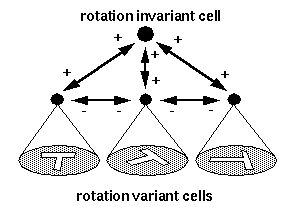Plato's Cave: Combinatorial Complexity
Combinatorial Complexity in Reification
The most direct and obvious way to implement invariance in visual
recognition is by defining an invariant node which can be activated by
any one of the variant feature nodes. For example the "T" feature
detector cells at different orientations, shown below, all stimulate
the same rotation invariant "T" detector cell.

In order to add top-down reification, the bottom-up links must be made
bidirectional, as shown below. Furthermore, in order to prevent
top-down activation of more than one feature cell at a time, a lateral
inhibition, or competitive interaction must be defined between the
rotation variant cells as indicated by the inhibitory (-) connections
below.

This scheme expands combinatorially when you consider rotation,
translation, and scale invariance, each of which expand the number of
required variant feature nodes, and even more so when you consider
"L", "+", "K", and other feature nodes, each of which would have to
posess the same combinatorial architecture.
Return to argument
Return to Steve Lehar


